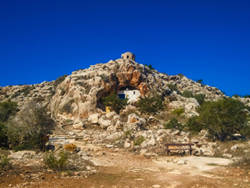Εξωκκλήσι Αγίων Σαράντα
Ayioi Saranta Cave Church - Agioi Saranta
Useful Information


| Location: |
Protaras.
(35.0050600, 34.0361844) |
| Open: |
no restrictions. [2024] |
| Fee: |
free, donations welcome. [2024] |
| Classification: |
 Cave Church Cave Church
|
| Light: |
 Incandescent Incandescent
|
| Dimension: | |
| Guided tours: | self guided |
| Photography: | allowed |
| Accessibility: | no |
| Bibliography: | |
| Address: | Agioi Saranta Cave Church, 5296 Protaras, Tel: +357-23-812444. |
| As far as we know this information was accurate when it was published (see years in brackets), but may have changed since then. Please check rates and details directly with the companies in question if you need more recent info. |
|
History
Description




Σπηλαιοεκκλησιά Αγίων Σαράντα (Cave Chapel of Ayioi Saranta), Εξωκκλήσι Αγίων Σαράντα (Ayioi Saranta Chapel) or sometimes Σπήλαιο Αγίων Σαράντα (Ayioi Saranta Cave) is a small cave church built into a natural cave in a hill overlooking Protaras. The cave was closed at the portal by a white wall with a blue door. A white stone cross makes clear that this is a church. The cave inside has been left almost untouched. Only the floor was paved and icons have been installed in crevices in the stone. On top of the Fanou hill is a stone cupola, which covers an opening in the cave ceiling. It is also helpful to find the church as it is easily visible. The cave is a Greek Orthodox church, but it lacks most typical internal structures like an iconostasis and the numerous candles. There are no internal structures, only the cave walls with a few icons at the walls. The result is a rather simple and unobtrusive atmosphere that invites you to linger and probably meditate.
Saranta means 40 in Greek and is linked to the legend of the 40 Martyrs of Sebaste. Forty stalactites on the ceiling of the cave are linked to this legend, hence the name. The Forty Martyrs of Sabaste were, according to legend, a group of 40 Roman soldiers of the Legio XII Fulminata. They were killed by Roman emperor Licinius I in 320 AD when they refused to renounce their Christian fate.
According to Saint Basil, Bishop of Caesarea (370-379), there were forty soldiers who had openly confessed themselves Christians. The local governor of Sebaste tried persuasion, promises, and torture to obtain their apostasy. When all this failed, he ordered them to be exposed naked upon a frozen pond near Sebaste on a bitterly cold night, that they might freeze to death. A fire and a warm bath were prepared on the bank to tempt them. Finally, one yielded and, leaving his companions, sought the warm baths, but upon immersion into the cauldron, he went into shock and immediately died. One of the guards, Aglaius, was set to keep watch over the martyrs and beheld at this moment a supernatural brilliancy overshadowing them. He at once proclaimed himself a Christian, threw off his garments, and joined the remaining thirty-nine. Thus, the number of forty remained complete. At daybreak, the stiffened bodies of the confessors, which still showed signs of life, were burned and the ashes cast into a river. Christians, however, collected the precious remains, and the relics were distributed throughout many cities.
Veneration of the Forty Martyrs became widespread in the East, being celebrated in sermons by Basil, Ephrem, John Chrysostom, and Gregory of Nyssa. There is some variation in the details of the story, like always. The feast day of the Forty Martyrs of Sebaste is on 09-MAR, when many Christian devotes come to pay their respects at the Agioi Saranta Cave Church. In the western church the story was also spread quite early, but the feast of the Forty Martyrs of Sebaste was celebrated on 10-MAR. According to the Oxford Dictionary, the feast was suppressed in the West in 1969, but still the 10-MAR is named Martyrs’ Day as a relict and some celebrate it as Men’s Day. This "suppression" is simply the result of the 1969 edition of the General Roman Calendar, where around 200 saints were removed.
Like many of those small churches in the countryside, there is no priest and no archive, it’s unknown when it was built and by whom. This cave church is even unknown to most locals.
It’s a bit tricky to find the cave. Only 1.6 km from the road, but it is necessary to navigate narrow unpaved roads. There are numerous roads and numerous hotels along those roads, so they are accessible. Only the last 800 m or so is a gravel road, and if you have a rented car, you might want to walk this last piece. However, the single lane gravel road is suitable for regular cars and ends at the cave church. Taxi drivers should know the cave church, but they are not particularly eager to go there due to the bad road, but we guess a taxi is the best option to go there. A short trail with many steps leads up to the cave in the hillside. The church is open all day, the blue door is closed but unlocked. Please close it when you leave. There are some military installations and a shooting range on the same hill, but if you read about a special permit required to visit the church, that’s nonsense.
- See also
 Search DuckDuckGo for "Ayioi Saranta Cave Church"
Search DuckDuckGo for "Ayioi Saranta Cave Church" Google Earth Placemark
Google Earth Placemark OpenStreetMap
OpenStreetMap Agioi Saranta Cave Church - Wikipedia (visited: 05-OCT-2024)
Agioi Saranta Cave Church - Wikipedia (visited: 05-OCT-2024) Ayioi Saranta Cave Church (visited: 05-OCT-2024)
Ayioi Saranta Cave Church (visited: 05-OCT-2024) Agioi Saranta Cave Church (visited: 05-OCT-2024)
Agioi Saranta Cave Church (visited: 05-OCT-2024) Agioi Saranta Cave Church (visited: 05-OCT-2024)
Agioi Saranta Cave Church (visited: 05-OCT-2024) Agioi Saranta Chapel, Protaras (visited: 05-OCT-2024)
Agioi Saranta Chapel, Protaras (visited: 05-OCT-2024)
 Index
Index Topics
Topics Hierarchical
Hierarchical Countries
Countries Maps
Maps